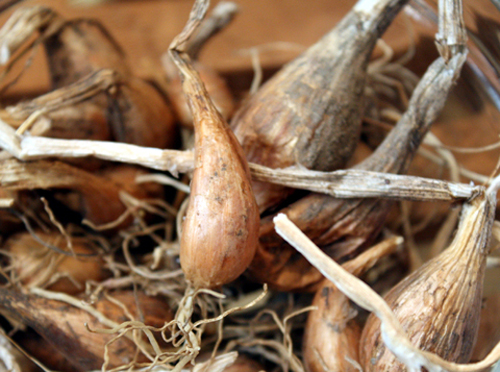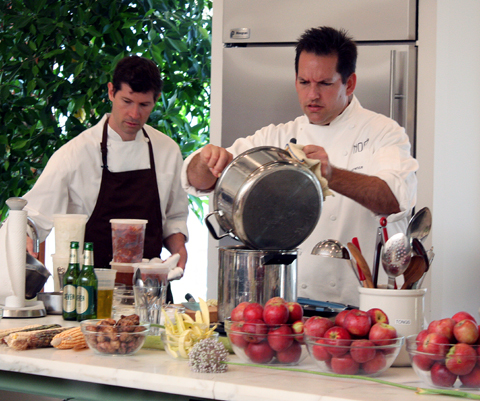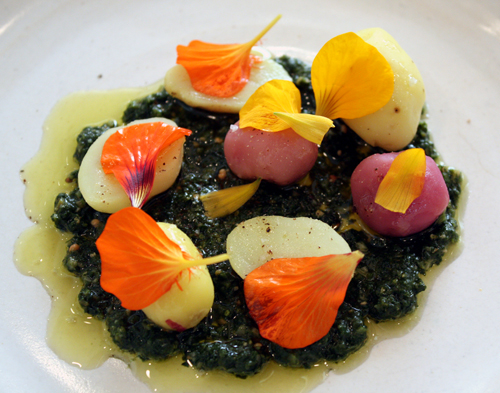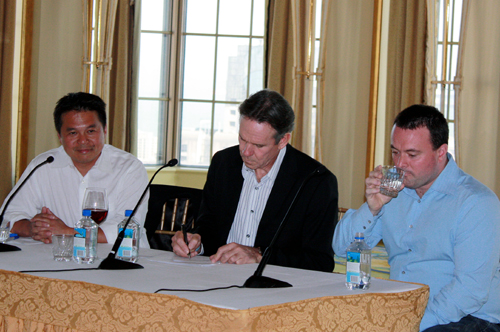The Dish on Heirloom Veggies and Culinary Luminaries at SF Chefs Food Wine Extravaganza

If you’ve ever needed proof of the value of saving and preserving heirloom seeds, just take a close look at the photo above.
That, my friend, is what a real, wild shallot looks like. It’s not big and purple, and encased in an easily removed papery shell like the commercially grown ones found at the supermarket here. No, this true shallot known as a gray shallot is much smaller and much more gnarly looking. You have to work to get at it, too, because its outer shell is quite hard to penetrate.
But your efforts are richly rewarded in the end with its beguiling fragrance and flavor that’s like that of a fine truffle.
Now, aren’t you just itching to get your hands on one? Unfortunately, it’s grown only in France now. Like so many varieties of heirloom produce (ones that have been propagated for at least 50 years and are not hybrids), they fell out of popularity after World War II, when our food became much more homogenized and industrialized. But nowadays, chefs and small-scale farmers are rediscovering these heritage fruits and vegetables, and finding inspiration in the stories and flavors they hold.
That was the theme of a Sunday cooking seminar at the SF Chefs Food Wine extravaganza in San Francisco, hosted by Chef Daniel Patterson of Coi in San Francisco, Laurence Jossel of Nopa in San Francisco, and Craig Lindquist, a Sonoma seed preservationist.

“These old varieties were woven into people’s lives,” Patterson says. “You used to save the seeds of the plants you liked. Over time, the plants adapted to where they were grown, so they took on the flavor characteristics of the place. We’ve lost a lot of that now.”

Flavor is front and center with these imperfect looking, finicky growing heirlooms. They may win no beauty contests, but they will win you over with their taste. One spoonful of Jossel’s bold pork chile, made with heirloom peppers that were dried and smoked, will make you a convert. One sip of Patterson’s onion soup with Parmigiana foam, will leave you wondering how it could taste so sweet from just onions and no added sugar.

This Rose Finn potato was grown in England in the 1700s. It was the favorite potato of organic gardening pioneer Alan Chadwick, who supposedly smuggled it back to Santa Cruz, where he grew them, Lindquist says. Nowadays, you can find them occasionally for sale at the Ferry Plaza Farmers Market, or served in season at the venerable Chez Panisse in Berkeley.
This fingerling potato fell out of favor because of its little bumps (secondary growth sites), Lindquist says. Consumers want uniform, pretty looking potatoes, not ones with little nubs all over them.
Patterson can’t get enough of potatoes like this, though. He loves their creamy, almost sweet flavor. He steams them, then serves them with salsa verde and edible blooms, or just a little drizzle of olive oil and sea salt.

“Maintaining diversity is very important,” Lindquist says. “These products have unique flavors. And heirlooms give us an experience we just don’t get elsewhere.”
Find out more about heirloom seeds at Seed Savers Exchange, a non-profit dedicated to saving and sharing them.

Big-name chefs were also on the marquee at another session of SF Chefs Food Wine on Sunday. Indeed, they don’t come much bigger than Thomas Keller of the French Laundry in Yountville, Douglas Keane of Cyrus in Healdsburg, and Charles Phan of the Slanted Door in San Francisco.
Moderated by San Francisco Chronicle food writer Amanda Gold, the panel discussed what it’s like at the “View From the Top.” Here’s a snippet from the sometimes hilarious, often insightful conversation:
On the stress of always being at the top of their game:
Keller: “All the accolades we have are from yesterday. We think about what we are going to do tomorrow.”
Keane: “When we opened Cyrus, our sole focus was to get four stars. We push ourselves harder than anyone else. Is there a fear of losing stars? Yes, in this economy, especially because we are one and a half hours north of San Francisco.”
Phan: “I’m constantly nervous. It’s never enough. And I never want to get bored.”
On coping with the dismal economy:
Keane: “We’re 10 percent down from last year. But it’s fine. We sort of live in a bubble in Wine Country because people come here precisely to eat. It’s their entertainment. We’ve made a few adjustments. I used to notice how much butter was coming back from the tables unused. So we got smaller butter containers. It saves us $30,000 a year. We also trimmed about a quarter inch off the brownies that we give out at the end of the night. That saves us $20,000 a year.”
Keller: “Of our restaurants, New York was hit the hardest. Our private dining there was just crippled. We had to lay off people. Bouchon struggled in Las Vegas. The managers took pay cuts and people are working fewer hours, but we didn’t have to lay off anyone. Yet in early 2009, Bouchon in Yountville had the best quarter it’s ever had.”
Phan: “Our first quarter was down 4 percent from last year. We added 40 seats outside. We are not selling the $80 bottles of wine now, but because we added more seats, our second quarter is looking better. July was up 5 percent from last year.”
On becoming a brand:
Keller: “I didn’t want to be a brand, but I realized I needed to be. So I started thinking of what kind of brand did I want to be. And I thought, ‘Hermes,’ because it’s the best brand around.”
Keane: (laughs) “If Hermes is taken, I want to be Gucci.”
Gold: Charles, Prada?
Phan: (laughs) Armani, maybe. It fits my body better. I’m 5’4”.
On being on TV:
Keller: “I have done some morning shows, but not the Food Network. I wouldn’t want to do that just because it takes so much time.”
Phan: “I don’t like TV. I don’t like seeing myself on TV. I just sat through a 13-hour photo shoot. It was painful!”
Keane: “I was a judge on ‘Top Chef’ the first season. The response afterward was just amazing. I’ve kept away from a lot of TV. I’m not comfortable with it. I was approached about doing ‘Top Chef Masters’ this year. Everything in me said ‘no.’ But I saw the downturn, and I thought maybe it would be good for the restaurant if I did it. It came down to the wire, but I just couldn’t bring myself to do it. Now that I’ve seen it, I’m glad I didn’t do it!”
On whether food bloggers and Yelp have impacted their restaurants:
Keller: “Yelp? What’s Yelp?”
Gold: (laughs) “I think that answers that question.”
Phan: “I never read it. I’ve heard about it. But it’s just too hard for me to read comments like that when people are hiding behind a veil.”
Keane: “We try to read all that we can. Sometimes you learn from the nastiness if you spot trends. So I don’t mind negative feedback because now and then, you learn something.”

N’awwww, that is the cutest shallot I’ve ever seen!
Chefs Food Wine sounds so interesting! I wish I could save $30,000 a year by getting a smaller butter container, haha. Looks like I’ll have to get a job instead…
well foodgal, the SF Chefs FoodWine extravaganza looks like it was the social event of the quarter! I’ll never try to think that working as a volunteer at one of these events is a way to see it from the inside in, but at least I was able to see some very interesting aspects of it here at your blog!
OK, I’m going to just take your word that those gray shallots taste amazing because I really love the purple color of a nice big bulb of shallots at the store. Sounds like there were some interesting panels this weekend, thanks for being our eyes and ears!
i loved the transcripts of the interviews with those three, BIG name chefs! too bad thomas keller doesn’t read his yelp reviews – his are probably some of the best on there! 🙂
The fingerling potatoes look amazing. Really delicious. If we start making smaller brownies, how much will we save a year?
Ah, you met Dr. Lindquist! I’ve only heard about him…like an apparition/Santa Claus who drops off delicious and unique vegetables of interest to bay area chefs! Perhaps he’d be worth a post of his own 😉
Separately, its very interesting to get the chefs’ perspectives on the real effects of the economy…particularly Chef Keller’s geographic breakdown. I also love Chef Keane’s approach to it all…he’s taking a closer look at the fine details and adapting….an approach that should be the norm whether in feast or famine.
Your recap of the interview with Keller, Phan, and Keane was very informative. You can get a little insight to how these chefs carry their restaurants and themselves. Was there any other interesting bits of info that the chefs shared?
Indigo: I’m with you! If I could save $30,000 a year by getting a smaller butter dish, I would GLADLY do so! If only! 😉
Lando: Those were the main highlights. Phan did say he would love to open a fine-dining Vietnamese restaurant some day. He already pictures it at the top of a glam high-rise building. Hmm, a Vietnamese-version of Per Se, perhaps?
And Chef Keller gave a big smile when I congratulated him on his engagement to his former director of operations, Laura Cunningham. He said the two will probably tie the knot next year.
Contrary to other reports published online elsewhere, Keller’s camp said there is no truth to the rumor that they are scouting locations and planning to open another restaurant in New York.
Beautiful heirlooms! I’ve noticed that shallots keep getting bigger. One shallot is too much for a vinaigrette now. I’d love to be able to buy those little, wild ones.
SF Chefs Food Wine looks like a dream event! How many cool and interesting chefs! We tried to get French Laundry reservations for our early Sept trip in July, but no luck. I guess it is THAT good!
Pingback: Giant Belgium Heirloom Tomato Seeds- 75+ Seeds | Grow Your Own Tomatoes
Pingback: Tomato Purple Cherokee 25 Vegetable Seeds *heirloom* | Grow Your Own Tomatoes
Pingback: 25 Pink Brandywine Heirloom Tomato Seeds Organic | Grow Your Own Tomatoes